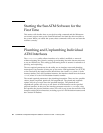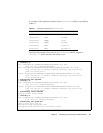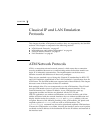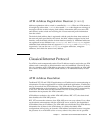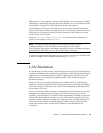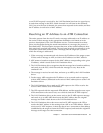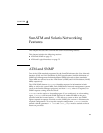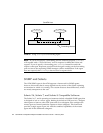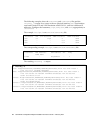
70 SunATM 3U CompactPCI Adapter Installation and User’s Guide • February 2001
The SunATM software implements the client side of the LAN Emulation standard.
To use LAN Emulation in an environment, several LAN Emulation services must
also exist in the emulated LAN. These services, called the LAN Emulation
Configuration Server (LECS), the LAN Emulation Server (LES), and the Broadcast
and Unknown Address Server (BUS), are generally provided in an ATM switch. The
following sections provide an overview of the functions of these servers.
LAN Emulation Servers
There are three types of LAN Emulation servers. Each type is briefly described in
this section.
LAN Emulation Configuration Server
This server is first contacted by a host interface when the host is brought up on the
emulated LAN. Its address is generally a well-known address specified by the LAN
Emulation standard that is coded into the host software; thus establishing this
connection requires no input from you. When contacted by a host wishing to join its
emulated LAN, the LECS replies with configuration parameters for the emulated
LAN, as well as the address of the LES.
LAN Emulation Server
The second step in joining an emulated LAN is to make a connection to the LAN
Emulation Server. After receiving the LES address from the LECS, a host will
establish a connection to the LES. The LES may add the host to a point-to-multipoint
call that is maintained by the LES with connections to every host in the emulated
LAN. This point-to-multipoint connection, if created by the LES, is used to send
control information to each host on the emulated LAN.
The LES acts as the ATM ARP server. Since IP and ARP work with MAC addresses,
an additional address resolution step is required to convert a MAC address to the
corresponding ATM address, which is used to make a connection to the target host;
this resolution step is provided by the LES.
Broadcast and Unknown Address Server
The final step in joining an emulated LAN is to make a connection to the BUS. The
ATM address of the BUS is obtained by sending a LAN Emulation ARP request to
the LES for the broadcast address. Once established, this connection is used to send
broadcast messages to the BUS, which will add the client to a point-to-multipoint
call including all hosts on the emulated LAN. Thus when a broadcast message (such



